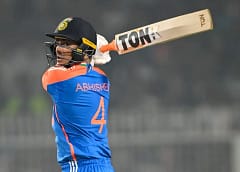Understanding the Dew Factor
- Seasonal Variability: Dew formation is more pronounced in winter due to significant temperature drops in the evening. In contrast, the temperature remains relatively high during summer, which minimizes dew formation. However, October-November, when many matches are scheduled, typically features less drastic temperature changes, thus reducing dew issues
- Geographical Influence: Bengaluru’s elevation (3,000 feet above sea level) contributes to lower humidity levels, further mitigating dew formation compared to other regions
Management Techniques
1. Chemical Sprays
Curators apply specific chemicals to the grass before matches. These sprays create a synthetic coating on the grass blades, allowing dew to slide off rather than accumulate as droplets. This process begins 2-3 days before a match and takes several hours to complete
2. SubAir System
The stadium features a SubAir system designed for rapid drainage and aeration of the outfield. It can remove water quickly and helps control moisture levels, potentially limiting dew formation. The system operates in two modes: suction mode for removing excess water and pressure mode for aerating the soil
3. Groundstaff Interventions
While traditional methods like mopping ropes are still employed, curators now focus on more effective interventions. They may use absorbent materials to manage any dew that does form during breaks in play.
4. Game Scheduling
Starting matches earlier can also help minimize Dew’s impact. This strategy is suggested as a rule change to ensure fair play conditions throughout the tournament.
By combining these techniques, curators at Chinnaswamy Stadium aim to maintain a level playing field and reduce the influence of dew on match outcomes, which can change T20 outcomes quickly.
How does the dew factor influence night matches at Chinnaswamy Stadium?
How a Dew is Formed?
When dew does form, it tends to benefit the batting side in the second innings. A wet ball can become difficult for bowlers to grip, particularly for spinners who rely on turning the ball. This can lead to easier scoring opportunities for batsmen, which T20 stats show over the years.
Toss Importance
The presence of dew can make the toss crucial, as teams winning the toss often prefer to chase rather than set a target. This trend has been observed in various day-night matches across India, where teams opt to bat second to take advantage of favourable conditions
Ground Management
Curators at Chinnaswamy Stadium employ various techniques to manage dew, including spraying chemicals on the outfield before matches to minimize moisture retention on grass blades. This helps prevent dew from forming droplets that can affect gameplay.
Drainage Improvements
The stadium has also seen upgrades to its drainage system to ensure that wet conditions do not disrupt play, further reducing the impact of any potential dew formation
What specific chemicals are used to minimize the dew effect at Chinnaswamy Stadium?
At Chinnaswamy Stadium, curators employ specific chemical sprays to minimize the dew effect during cricket matches. These chemicals create a synthetic coating on the grass blades, allowing dew to slide off rather than accumulate as droplets. This method helps prevent the ball from becoming wet, hindering bowlers’ grip and affecting gameplay.
Chemicals Used
- Apsa 80: This common agricultural adjuvant sticks to grass blades, ensuring that dew slips off easily. However, its effectiveness lasts only a few hours and can diminish with maintenance activities like mowing or using super-soppers.
- Synthetic Coating Sprays: Curators have mentioned using sprays that form a synthetic layer on the leaves. When dew forms, it slides down instead of remaining on the grass, which is crucial for maintaining the playing conditions.
Final Words
While chemical sprays are effective, they are part of a broader strategy that includes maintaining shorter grass and managing watering schedules to reduce dew formation further. The stadium’s management also utilizes aeration systems to help control moisture levels in the outfield.
While completely eliminating dew is impossible, these techniques significantly mitigate its impact on match conditions at Chinnaswamy Stadium.
While dew can influence night matches at Chinnaswamy Stadium by favouring batting sides and complicating bowling efforts, its overall impact is less pronounced than at many other Indian venues. The management strategies help mitigate these effects, allowing for a more balanced contest between batters and bowlers during evening games.





